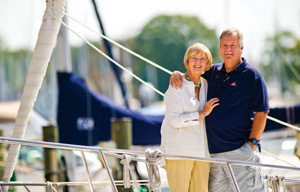 Avid sailing enthusiast and self-professed “water baby,” Pat Casey, along with her husband, Joe, is used to navigating the unpredictability of the sea. Having sold their beloved sailboat in 2012, the Casey’s search for a new vessel came to an abrupt halt in April of 2013 when Pat was airlifted to the R Adams Cowley Shock Trauma Center. What should have been a simple recovery from two routine procedures performed at another hospital had quickly turned into a combination of extreme complications, including a necrotizing intra-abdominal infection, severe septic shock, and respiratory failure.
Avid sailing enthusiast and self-professed “water baby,” Pat Casey, along with her husband, Joe, is used to navigating the unpredictability of the sea. Having sold their beloved sailboat in 2012, the Casey’s search for a new vessel came to an abrupt halt in April of 2013 when Pat was airlifted to the R Adams Cowley Shock Trauma Center. What should have been a simple recovery from two routine procedures performed at another hospital had quickly turned into a combination of extreme complications, including a necrotizing intra-abdominal infection, severe septic shock, and respiratory failure.
Upon arrival at the R Adams Cowley Shock Trauma Center, Jose J. Diaz, MD, chief, Division of Acute Care Surgery, notes that, “Ms. Casey presented extremely ill and, she developed severe life-threatening bleeding which required the concerted effort of teams from the Interventional Radiology service, the Surgical Intensive Care Unit, and the Acute Care/Emergency Surgery service and many others. We were successful in getting her through a near death illness.”
Every year, 8,000 people are brought to the Shock Trauma Center with critical conditions, ranging from vehicle accidents to acute critical illness. Because of the intricate, complex care that is provided by Shock Trauma, “we can leverage our unique network of resources to manage dangerous conditions like Ms. Casey’s,” notes Dr. Diaz. “Thankfully, we stabilized her for the multiple surgeries necessary for her ongoing course of treatments.” From April to December of 2013, Pat underwent 23 surgical and interventional procedures, nearly 60 CT Scans and X-rays, and relied on breathing support. “Ultimately, we performed an extensive reconstruction of her GI tract and abdominal wall and she’s returned to normal activities after a remarkable recovery,” continues Dr. Diaz.
“It wasn’t until mid-May that I understood I was in a hospital and something was seriously wrong” Pat recalls. While her memories of those initial months are understandably vague, Pat remembers the presence of “competent and caring people focused on the endless details necessary to keep me alive. They never lost sight that there was a broken human in the bed who could easily be in pain and was probably scared.” At the same time, they “welcomed me as a participant in each morning rounds when Pat’s case was reviewed,” says Joe. “They were always very responsive to my questions and concerns,” he continues.
Throughout Pat’s recovery, she and Joe used their keen attention to detail to document their experiences. Pat notes, “my respect and admiration for the doctors, nurses, technicians and administrative personnel grew as my body gained strength and my mind accepted the situation.” Once stable, she was admitted to the University of Maryland Midtown Campus Acute Rehabilitation Ward where, during her two month stay, she relearned to walk, learned to perform everyday tasks, and gained strength while waiting for reconstructive surgery.
Curious by nature, Pat took great interest in the approach of the clinical teams. “I believe strongly in academic medicine and the benefits of a teaching hospital,” Pat says. “The mix of experienced doctors side-by-side with the next generation of physicians was important to me and to other patients. I particularly appreciated the enthusiasm of the residents who queried me in the (very) early morning hours. Everyone was very respectful of my privacy, and since my physical circumstances were so unique, I was something of an attraction at times,” she recalls.
In July 2014, six months after Pat’s last surgery at UMMC, she and Joe took possession of a 36’ Down East cruiser they named Otter. Applying the same focus essential to Pat’s recovery, the Caseys began planning an ambitious passage navigating the Intracoastal Waterway from Annapolis to Daytona Beach, Florida. “I was delighted to be cleared to go,” Pat says. “However, Dr. Diaz warned me: No street food along the way!”
While in Charleston, SC on Christmas Day, Pat penned a heartfelt letter accompanying a generous gift in honor of the Shock Trauma Center and Acute Care/Emergency Surgery teams “in recognition of their skills in putting the pieces back together and giving my body the time it needed to heal. Am I perfect? No, but I wasn’t perfect before April 2013. I am so much better than perfect. Thank you, STC/ACES for giving me more of what is truly important: life and time."
To make a gift in support of the Shock Trauma Center, please click here.